中西文化之鉴 – 跨文化交际 第九单元
- 格式:ppt
- 大小:5.78 MB
- 文档页数:16
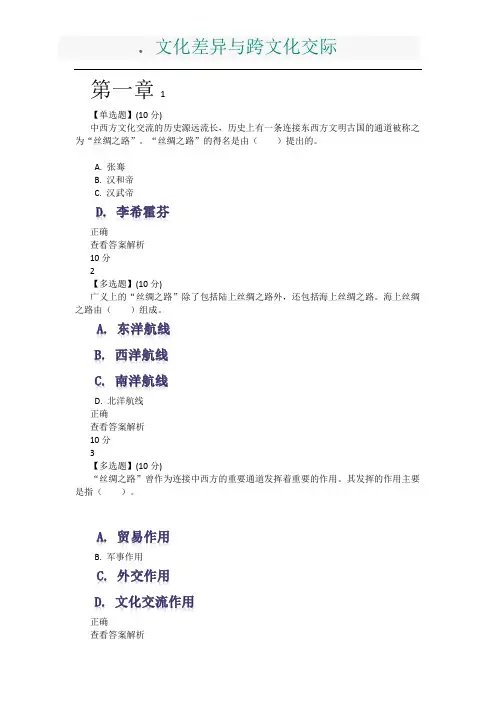
第一章 1【单选题】(10分)中西方文化交流的历史源远流长,历史上有一条连接东西方文明古国的通道被称之为“丝绸之路”。
“丝绸之路”的得名是由()提出的。
A. 张骞B. 汉和帝C. 汉武帝正确查看答案解析10分2【多选题】(10分)广义上的“丝绸之路”除了包括陆上丝绸之路外,还包括海上丝绸之路。
海上丝绸之路由()组成。
D. 北洋航线正确查看答案解析10分3【多选题】(10分)“丝绸之路”曾作为连接中西方的重要通道发挥着重要的作用。
其发挥的作用主要是指()。
B. 军事作用正确查看答案解析10分4【单选题】(10分)通过“陆上丝绸之路”,于()年粟特人将制造葡萄酒的技术传入中国。
B. 康熙九年C. 崇祯十六年D. 元和七年正确查看答案解析10分5【单选题】(10分)汉武帝时期,()为开拓“丝绸之路”立下了汗马功劳,被誉为“中国走向世界第一人”。
A. 卫青B. 霍去病D. 司马迁正确查看答案解析10分6【多选题】(10分)鸠摩罗什把佛教从西方引入中国,将大量经书翻译成汉语,为佛教在中国的传播做出了巨大的贡献。
他与()和玄奘并称为中国佛教四大译经家。
B. 鉴真C. 法显正确查看答案解析10分7【单选题】(10分)()17岁时跟随父亲和叔叔历时四年来到中国,与元世祖忽必烈建立了友谊。
后由鲁斯蒂谦将其在中国见闻轶事整理并编著成游记,在欧洲广为流传,激起了欧洲人对东方的向往。
A. 查理·马特C. 利玛窦D. 阿基米德正确查看答案解析10分8【多选题】(10分)佛教传入中国后对中国文化的影响巨大。
中国历史上就曾修建过许多反映佛教文化的石窟,其中敦煌莫高窟与()并称为中国四大石窟。
A. 固原须弥山石窟正确查看答案解析10分9【多选题】(10分)利玛窦不仅将中国文化介绍到了西方,而且帮助中国人打开了视野,使中国人了解到了西方。
正是由于他的到来,使中国人第一次接触到了()。
D. 西方哲学正确答案是:A,B,C查看答案解析10【多选题】(10分)“丝绸之路”加强了东西方的贸易往来。

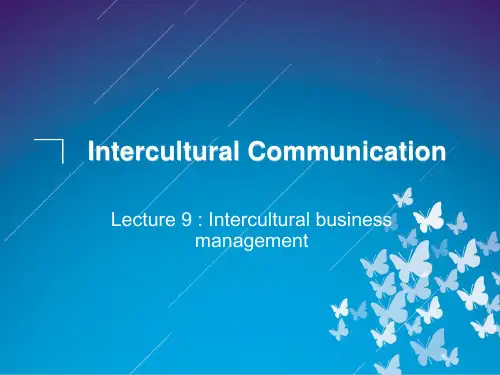
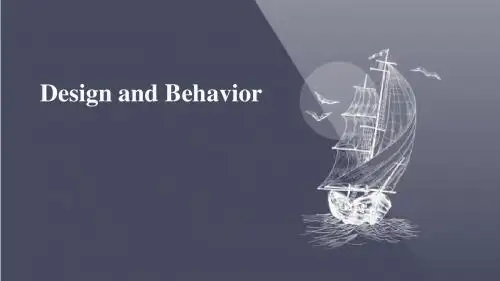

Unit Nine Intercultural AdaptationI.Warm UpPlease read the story on page 298 . What can we learn from this case about the Japanese culture?II.Culture ShockRead the article “Adapting to a New Culture” (p299-304). What is culture shock? How to adapt to a new culture?※Culture shock can be described as the feeling of confusion and disorientation that one experiences when faced with a large number of new and unfamiliar people and situations.(from College English, 2005,14th,10)※◆当人们去到一个与自己原来的文化迥异的地方时,绝大多数人都会经历一种心理上的迷惑,这就是文化冲击。
——Robert Kohls(Survival Kit for OverseasLiving)1.Culture shock, or the early adaptation phase of transitioning into a newculture, refers to the transition period and the accompanying feelings of stress and anxiety a person experiences during the early period upon entering a new culture.2.Symptoms of culture shock: physiological, emotional, communication.(p299)3.Causes to culture shock: Culture shock is caused by the anxiety thatresults from losing all our familiar signs and symbols or social contact.4.Will culture shock affect everyone who enters a new country? Is thereany individual differences? Why?Individuals differ greatly in the degree in which culture shock affects them. The severity of culture shock depends on people’s personalities, language ability, emotional support, and duration of stay停留时间. It is also influenced by the extent of differences between the two cultures.5.Forms of culture shock(1)Language shock(2)Role shock(3)Transition shock(4)Cultural Fatigue(5)Education Shock(6)Adjustment Stress(7)Culture Distance◆Keep in mind :First, most people experience some degree of culture shock when they go to a new country. Second, culture shock passes with time.6.Four stages in getting used to life in a new country:1)Euphoria欢快: the first stage when everything seems wonderful withgreat happiness, a sort of honeymoon period.2)Depression, or culture shock: the stage despair when people tend to bevery critical of the country they’ve moved to, blaming it for their problems.3)Adjustment: the stage when people become better at coping with theirnew situation and feel happier and more confident.4)Acceptance: the stage when people finally get used to the new way oflife.Read Case 33 on p317-319 and identify the different stages revealed in each letter.U-curve patternW-curve Pattern7.how to cope with culture shock and adapt to a new culture: (p303-304) When one is experiencing culture shock, the best thing to do is to admitthat he/she is experiencing culture shock, try to identify your stage of culture shock, and work toward becoming more familiar with the new culture.(1)Do not become over-reactionary.保守(2)Meet new people.(3)Try new things.(4)Give yourself periods of rest and thought.(5)Work on your self-concept.(6)Write.(7)Observe body language.(8)Learn the verbal language.8.Two views of culture shock (p306-308)1.the disease view:1)The culture-shocked person experiences a breakdown incommunication, is unable to cope, and feels isolated and lost, thus develops a number of defensive attitudes and behaviors to protect the mind from the confusion of an entirely new situation.2)In this disease view, the culture-shocked person is a helpless victim;the only things to do are to adjust to the new culture somehow or to leave the culture quickly.3)In this view, people can experience many different emotional andmental difficulties. The culture-shocked person may start to glorify赞美the home country; people can become physically ill from the stress of culture shock.2.the self-awareness自我意识view:1)Culture shock can be part of a positive learning experience. Cultureshock, if handled well, can lead to profound self-awareness and growth.2)Learn a second language, observe different customs, and encounternew values.3)Enable people to gain insight into their own society; develop adeeper understanding of themselves and of the society that helped to shape their characters; provide a mirror in which one’s own culture is reflected.◆The major difference of these two views is in the attitude of aperson towards culture shock.III.Intercultural Adaptation1.Intercultural adaptation refers broadly to the process of increasing ourlevel of fitness to meet the demands of a new cultural environment.2.Read the article “Overcoming Ethnocentrism in Communication”(p309-313).1)In intercultural communication we tend to use the categories of ourown culture to judge and interpret the behaviors of the others who are culturally different from us. These ethnocentric impressionspredispose us to evaluate others negatively. When communicators engage in mutual互相的negative evaluation, the communication event may deteriorate恶化even further. With each turn of this regressive spiral螺旋向下, negative evaluations否定评价are intensified.2)Examples: American-Japanese; American-Nigerian; American-Thai;American-British;3)How to overcome ethnocentrism:We can overcome ethnocentrism by approaching every cross-cultural situation as a kind of experiment. Using available generalizations 概括about the other culture, we can formulate制定a hypothesis假设and then test it for accuracy. As more knowledge of relevant cultural differences is acquired, generalizations can become more specific, hypotheses more particular, and communication difficulties more predictable.IV.Case Study: Students are required to read the cases given carefully and try to analyse them from the viewpoint of IC.。
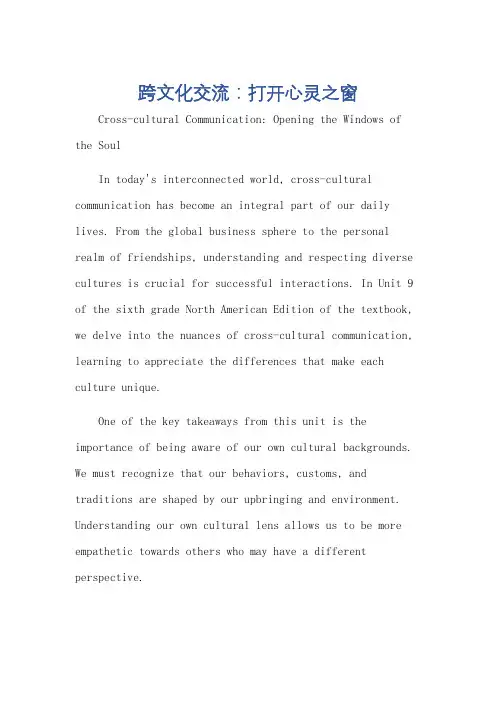
跨文化交流:打开心灵之窗Cross-cultural Communication: Opening the Windows of the SoulIn today's interconnected world, cross-cultural communication has become an integral part of our daily lives. From the global business sphere to the personal realm of friendships, understanding and respecting diverse cultures is crucial for successful interactions. In Unit 9 of the sixth grade North American Edition of the textbook, we delve into the nuances of cross-cultural communication, learning to appreciate the differences that make each culture unique.One of the key takeaways from this unit is the importance of being aware of our own cultural backgrounds. We must recognize that our behaviors, customs, and traditions are shaped by our upbringing and environment. Understanding our own cultural lens allows us to be more empathetic towards others who may have a different perspective.For instance, when communicating with someone from a different culture, it's essential to be mindful of their communication styles. Some cultures prefer direct and frank communication, while others prefer a more indirect and subtle approach. By being aware of these differences, we can avoid misunderstandings and conflicts.Moreover, respecting cultural norms and values is paramount. Different cultures have different taboos and sensitivities, and it's crucial to educate ourselves about these before engaging in cross-cultural communication. For example, certain topics may be considered taboo in certain cultures, while they may be freely discussed in others.It's essential to be aware of these differences and respect them.However, cross-cultural communication is not just about following rules and avoiding conflicts. It's also about opening our minds to new ideas and perspectives. By engaging with people from different cultures, we can broaden our horizons and gain a deeper understanding of the world. This, in turn, makes us more tolerant and understanding of others.In conclusion, cross-cultural communication is a vital skill that everyone should possess. It not only helps us in our professional lives but also enriches our personal relationships. By being aware of our own cultural backgrounds, respecting others' norms and values, and opening our minds to new ideas, we can create a more inclusive and understanding world.**跨文化交流:打开心灵之窗**在当今互联互通的世界里,跨文化交流已成为我们日常生活的重要组成部分。
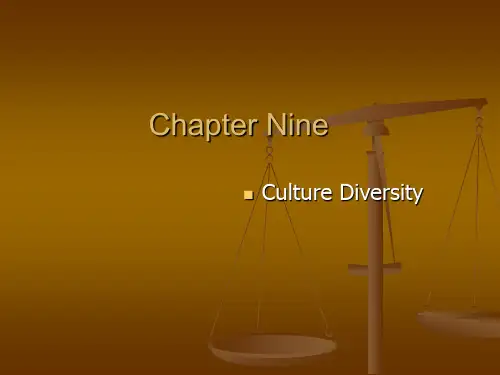



Chapter 3:Making GeneralizationsWhen people have little information about a group of people they are likely to think of them in a very general way。
If the other people with whom they interact also lack information about that group, they are likely to share an overly generalizing based on limited or inaccurate information is called stereotyping。
We all make generalizationsEveryone generalizes every day just to make sense of his experience。
No one can respond to every situation as if it were entirely new and unique。
A student anticipating a class taught by a teacher he has never met, generalizes from his experience that teachers have certain typical behaviors, opinions, and expectations。
The student interacts with the new teacher he meets based on the generalizations he has made from his previous teachers. This is normal and sensible. The student may have a problem, however, if the generalization he makes is too broad or is based on inadequate or outdated information。
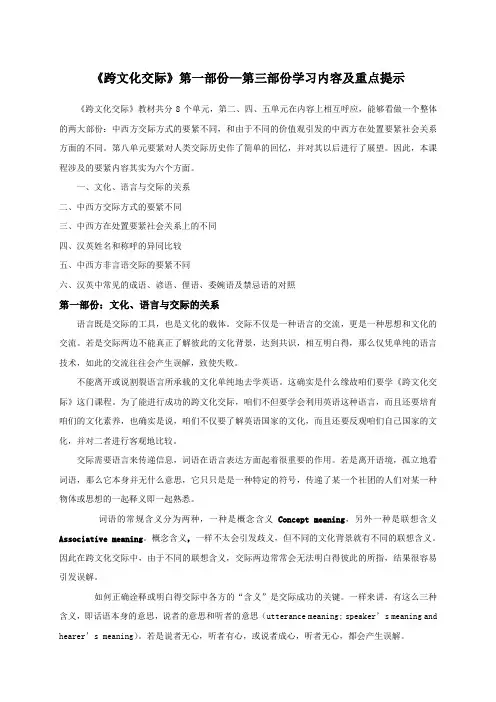
《跨文化交际》第一部份—第三部份学习内容及重点提示《跨文化交际》教材共分8个单元,第二、四、五单元在内容上相互呼应,能够看做一个整体的两大部份:中西方交际方式的要紧不同,和由于不同的价值观引发的中西方在处置要紧社会关系方面的不同。
第八单元要紧对人类交际历史作了简单的回忆,并对其以后进行了展望。
因此,本课程涉及的要紧内容其实为六个方面。
一、文化、语言与交际的关系二、中西方交际方式的要紧不同三、中西方在处置要紧社会关系上的不同四、汉英姓名和称呼的异同比较五、中西方非言语交际的要紧不同六、汉英中常见的成语、谚语、俚语、委婉语及禁忌语的对照第一部份:文化、语言与交际的关系语言既是交际的工具,也是文化的载体。
交际不仅是一种语言的交流,更是一种思想和文化的交流。
若是交际两边不能真正了解彼此的文化背景,达到共识,相互明白得,那么仅凭单纯的语言技术,如此的交流往往会产生误解,致使失败。
不能离开或说割裂语言所承载的文化单纯地去学英语。
这确实是什么缘故咱们要学《跨文化交际》这门课程。
为了能进行成功的跨文化交际,咱们不但要学会利用英语这种语言,而且还要培育咱们的文化素养,也确实是说,咱们不仅要了解英语国家的文化,而且还要反观咱们自己国家的文化,并对二者进行客观地比较。
交际需要语言来传递信息,词语在语言表达方面起着很重要的作用。
若是离开语境,孤立地看词语,那么它本身并无什么意思,它只只是是一种特定的符号,传递了某一个社团的人们对某一种物体或思想的一起释义即一起熟悉。
词语的常规含义分为两种,一种是概念含义Concept meaning,另外一种是联想含义Associative meaning。
概念含义,一样不太会引发歧义,但不同的文化背景就有不同的联想含义。
因此在跨文化交际中,由于不同的联想含义,交际两边常常会无法明白得彼此的所指,结果很容易引发误解。
如何正确诠释或明白得交际中各方的“含义”是交际成功的关键。
一样来讲,有这么三种含义,即话语本身的意思,说者的意思和听者的意思(utterance meaning; speaker’s meaning and hearer’s m eaning)。
《跨文化交际》教学大纲辅导老师:适用班级:09春/秋英语(本科)单元简述第一单元语言、文化与交际内容:介绍语言、文化和交际之间的关系,跨文化交流模式,交流中的各种意义等。
教学目的:帮助学员认识到语言和文化是不可分的,对语言的充分理解需要文化意识。
学习目标:通过各种练习了解决定交际质量的基本要素,认识交际双方在交际过程中的交互作用,把握交际场合的定义、程式和价值观等。
第二单元文化冲击内容:介绍不同文化背景的人接触时常常感到的种种“文化诧异”现象。
教学目的:通过对各种“文化诧异”现象的分析培养学员的文化意识。
学习目标:通过练习认识到英汉在好客、谦逊、隐私、礼貌等方面的文化差异,进一步体会不同的文化价值观对交际行为的影响,初步学会如何适应一个新的文化环境。
第三单元姓名里的文化内容:姓名、称呼语和亲属语中的文化内涵。
教学目的:通过对姓名、称呼语和亲属语中的文化内涵的分析,使学员更加清楚地认识到英汉在这方面的文化差异。
学习目标:通过各种练习学会正确使用姓名、称呼语和亲属语。
第四单元人际间的交互作用内容:介绍在处理日常生活琐事过程中人际间的交互作用。
教学目的:培养学员对人们在处理日常生活琐事过程中不同行为模式的认识。
学习目标:通过练习学会处理邀请、约会、付帐、馈赠、请求、恭维、招待等行为中的文化差异,了解其中的一些不成文规则,更清楚地意识到自己的行为是如何受本族文化影响的。
第五单元角色和关系内容:介绍社会角色,如男和女、父母和孩子、朋友、社会身份等中的文化内涵。
教学目的:帮助学员分析社会角色和关系在不同文化中的期望值。
学习目标:意识到不同角色的不同期望值;意识到不同角色的不同责任;做到同其他文化背景的人交往时能够调整自己的期望值。
第六单元体态语交流内容:介绍体态语在跨文化交际中的重要作用。
教学目的:使学员熟悉不同种类的体态语以及不同文化对体态语的不同解释。
学习目标:通过练习能够描述体态语的不同意义;意识到成功的跨文化交际不仅需要知道如何用语言表达,而且要知道伴随恰当的体态语,在交流中有意识地注意脸部表情、目光接触、手势和身体位置、身体距离等。
第一章跨文化语言交际概述第一节文化、语言和交际一、关于文化的概念(一)文化的内涵和特性1、关于文化的内涵概括地讲,文化即是人们所思、所言(言语和非言语)、所为、所觉的总和。
在不同的生态或自然环境下,不同的民族创造了自己特有的文化,也被自己的文化所塑造。
交际即文化,文化即交际,如果没有交际,文化是难以形成的。
科学的提法是:“文化是冻结了的人际交流,而交际是流动着的文化。
”2、关于文化的特性(1)文化由人们的内稳和外显的行为组成。
(2)文化是通过符号被人们习得和传授的知识。
(3)文化是群体行为规则的集合。
(4)文化与社会是潜在现实中两种类型或两个层面上的概念。
(5)文化是历史所衍生及选择的传统观念。
(6)文化和交际具有同一性。
(7)文化是动态多变的。
(8)文化具有选择性。
(9)文化是群体或民族中心主义的意识产物。
(10)文化是个非常复杂的系统。
(二)文化定势、群体文化、亚文化1、文化定势和群体文化世界上大多数社会中都可能存在着若干群体或社团,这些群体或社团对地域、历史、生活方式、世界观,以及价值观等方面的共享,使其成员形成并发展和强化了自己独特的文化和与其相关的交际文化。
存在两种不同类型的文化范畴:一是全民族的文化,即整体的文化形象,二是具体的个性文化,即是按个人的社会情况或个人所属文化群体为基础的文化,有的学者把这种文化称之为群体文化或副文化。
2、亚文化与亚群体在跨文化交际研究中,对文化分类的一种较为传统的做法是把文化分成主流文化和亚文化。
亚文化是指存在于某一主流文化之中的一种非主流文化,某一少数群体的文化,这一文化中的行为模式区别于主流文化的行为模式。
二、关于语言的概念(一)语言是交际工具1、交际媒介言语交际是人类社会中必需的另一种交换活动,交换的是信息、思想、情感。
语言就是一个符号系统,一个人脑子里贮存了符号和符号的组合规则,他就可以和别人交际,传情达意,沟通信息。
2、符号功能符号是用某种能感知的形式来代表某种事物或现象的结合体。